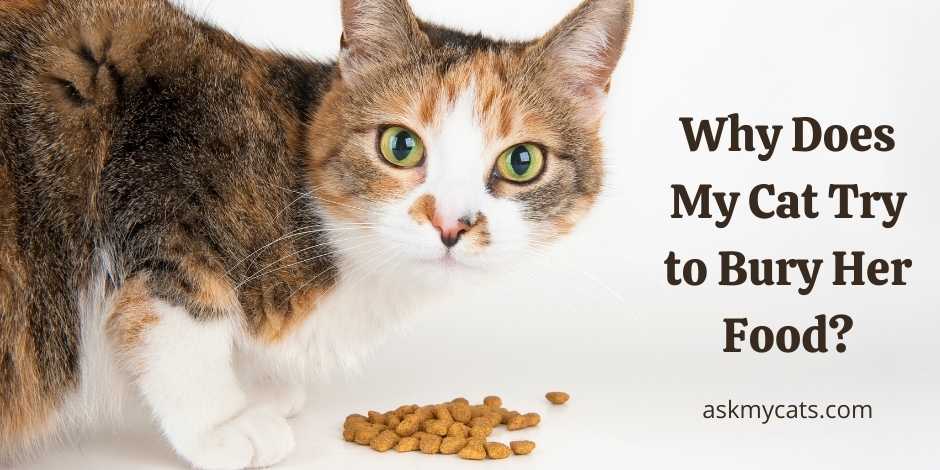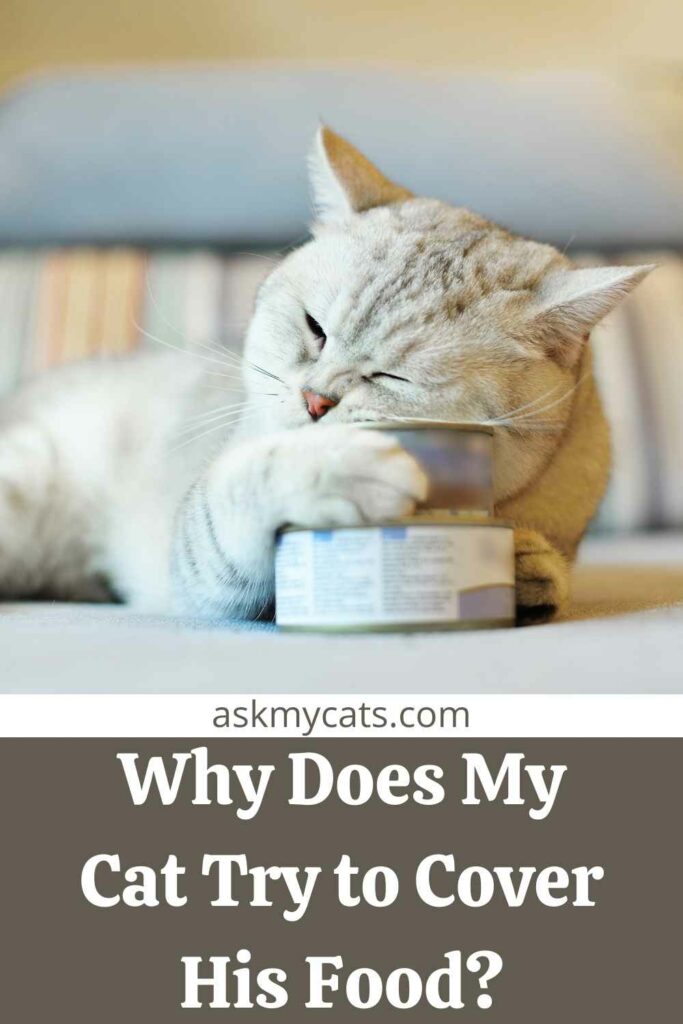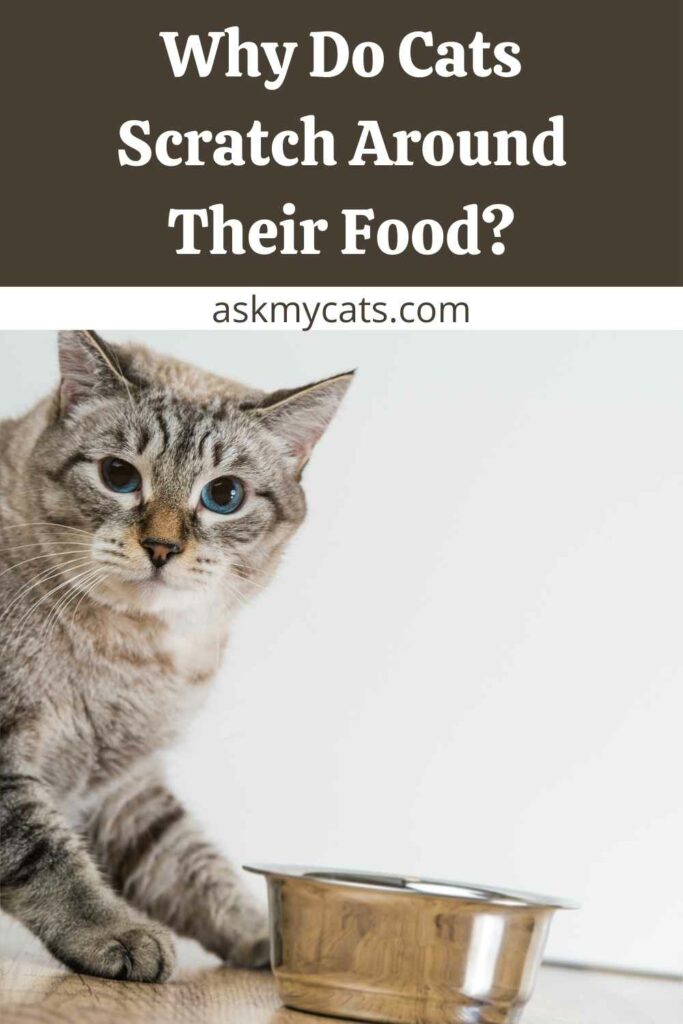One especially perplexing activity is your cat pawing and scraping about their food in what appears to be an attempt to hide it. What’s the deal with that? It may appear strange, but there is a reasonable explanation for this behaviour – at least in your cat’s thinking!
Cats pawing around their food as though attempting to bury it is a ritual they do even with food they have already eaten and enjoyed. Cats attempting to hide their food by burying show a very good indicator that they are at ease in your house.
Let’s look at the most common reasons why cats try to bury their food in this article.


Give Your Cat the Perfect Day
Get the Free Ebook!
Why Does My Cat Try to Cover His Food?
When your cat tries to bury or otherwise cover their food, this is known as “caching.” Caching is a technique used by wild cats to secure food from other cats or scavengers, to keep it from rotting, or to have something to come back to when there isn’t any other food available.

1. Saving It for Later
The explanation may not be due to all of the aforementioned natural inclinations; it may simply be due to the fact that you have to offer them too much food in one session!
If they consume as much as they desire and there are still leftovers, they may hide the food for later discovery. This is known as “food caching,” and it is more common in dogs (burying a bone), but it can also be seen in cats.
If they wish to return to the meal, they must first ensure that it is still available. Burying the food ensures that no one else comes along and consumes it before they can return.
Burying meat from other animals for their wild diet can also assist to preserve the food. Meat that is left out in the hot heat can get rancid and become inedible. Burying the food will keep it cool underground, extending its life.
2. Don’t Like to Share
Many wild cat species live alone, even those who live in groups, such as lions, like to remain relatively lonely. Because of their anti-social tendencies, they aren’t particularly excellent sharers!
For your domestic cat, additional pets in the house may be seen as competition for the hard-earned food that they sought (by meowing at their owners until kibble rained down!) When they have done eating, they may wish to cover the food to prevent other pets from eating it.
If there are new arrivals to the home and your cat is not delighted about it, you may observe this behaviour. This conduct might also be considered subservient to other pets in the family.
A more dominant cat would simply act violent to others in the vicinity of their food dishes. Submissive cats will just hide the food so that it is not consumed by others.
3. Like To Be Clean
Any cat owner will tell you that cats can be a lot of work. If they aren’t sleeping, they are most likely cleaning! This cleaning is mostly self-grooming, but they like a clean surroundings as well.
The desire to hide old food stems from the same urge that drives them to cover their waste in the litter box. Your cat’s “territory” or “den” is simply where it feeds and spends its time. It’s a survival instinct to keep this place tidy. Other animals, illnesses, and mould will be drawn to their dwelling place if there is old food present.
It is in a cat’s best advantage to maintain its environment clean so that they do not become ill.
4. Covering Tracks
They may leave a lot of odours in the vicinity after a meal, alerting predators that they have been there. So, by covering their food, they are also hiding their scent. This habit is particularly common in cats that are pregnant or nursing kittens.
Cats that would normally wander their territory in the wild will have limited movement due to their immobilised kittens, much as they would in the wild. It is critical for them to conceal their scent in order to safeguard their offspring.
Furthermore, even apex predators (animals at the top of the food chain) such as cats may disguise their traces despite the threat of predation. Submissive cats will hide their smell so that other aggressive and dominant cats in the neighbourhood cannot find them.
Why Do Cats Paw Around Their Food?
Pawing at food is a natural and harmless activity for cats. Cats will “fake cover” their food with scratching to disguise their traces and keep predators at bay. In certain circumstances, they even cover their dish with things such as towels.
Your kitten or older cat may knead, scratch, or softly paw the floor around their food bowl before or after feeding time. It may appear that your kitty is attempting to dig or bury something, which may remind you of their litter digging behaviour.
While there is nothing wrong with this habit, it may appear unusual at first, but cats aren’t the only ones that display it!
Burying food deep in the earth helped preserve it and kept other predators, like cats, at bay. Bones and corpses were maintained in subterranean “refrigerators,” which were critical for survival.
The only difference between the two is that cats normally eat as much of the prey as they can and bury the carcasses to avoid getting caught, rather than consuming it afterwards.
Why Do Cats Scratch Around Their Food?
If you give your cat large servings that she doesn’t finish in one sitting, you could observe them scratching at the food when they’re done.

In your kitty’s view, the extra food may be something she won’t return to once she’s finished, especially if it’s wet food. Because wet food does not retain moisture for very long and does not last very long, it might be your cat’s way of notifying you that she will not be getting any of that later.
If you have a female cat with kittens at home, she will bury the food to protect her children from other predators. A cat, like a dog, strives to keep others from discovering that there are kittens around, just as she does with her own smell.
Another reason a cat may conceal her food is her natural neatness. Most felines are creatures who are obsessed with cleanliness, thus they work hard to be pristine and keep their surroundings clean.
Cats are obligate carnivores, which mean they must hunt for food in the wild. They obtain food leftovers from hunting and eating portionally, and they need to hide them so other predators don’t scent them.
Your domestic cat’s instinctive inclination is to bury food leftovers. As a result, she wishes to conceal the scent, as it may signal predators to her presence.
Controlling the quantities you offer your cat is the greatest way to keep this behaviour at bay and make feeding time a little less stressful and a lot more enjoyable. This will assist to reduce scratching while also keeping the food fresh and avoiding cat obesity and other health concerns.
Why Does My Cat Scratch The Floor After Eating?
If your cat scratches the floor after eating, it is just his or her instinct to protect himself or herself from predators.
In the wild, it is critical for cats to bury their leftovers after finishing meals in order to disguise their traces. As a result, predators are less likely to be drawn to the fragrance of food.
Food coaching can also explain cats pawing at the floor. Cats, like cheetahs and leopards, will conceal their food before devouring it. Trying to hide food is a protective strategy used to deter other animals from consuming their leftover food.
In rare circumstances, cats knead the floor in order to dig a hole in which to bury food or other objects they despise. Burying, like caching, helps cats to get rid of their faeces and other unwanted items. They have an innate need for a clean and tidy habitat, thus burying food waste helps them to do so.
Frequently Asked Questions
Why Is My Cat Scratching The Floor Near Her Food And Not Eating?
Her scratching the floor indicates that she is not hungry and is “burying” the food for later. They’ll go to their bowls, eat a few bites, and then “buried” it. Because most cats are skilled at self-regulating their intake, don’t try to push it; otherwise, your cat may develop undesirable habits and become overweight.
What does it mean when cat scratches around food?
Cats will scratch at or hide food or other objects they detest in some instances. This is comparable to burying excrement in a litter box or on the ground. Burying, like caching, allows the cat to “disappear” by disposing of its waste.
Why does my cat scratch around his water bowl?
A cat pawing at and playing with or even splashing in a water dish is not as uncommon as you may assume. Moving water is preferred to water that lies static in a dish for hours, according to some cats. As a result, some cats prefer to drink aerated water straight from the faucet, a fountain, or even the toilet.
Final Words
In the wild, a cat may try to bury or conceal any uneaten food in order to avoid attracting predators. It’s also an attempt to avoid alerting any other prospective prey that a feline hunter is around. Cats aren’t scavengers, therefore they don’t bury food to eat later; it’s solely for safety.
Even an indoor cat that has never been outside keeps this survival drive; it’s only a matter of how much it bothers them, which decides how much the behaviour is expressed.
Drop your questions in the comments section below.
